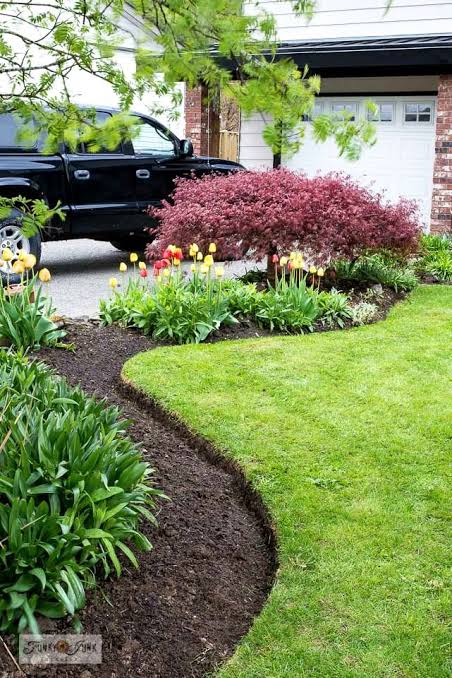Starting a garden bed might sound like a big project, but with a few simple tricks, anyone — beginner or expert — can grow lush, healthy plants right in their backyard. Whether you want vibrant flowers, fresh vegetables, or fragrant herbs, learning how to garden bed successfully will transform your outdoor space into a beautiful, thriving oasis.In this guide, you’ll discover easy, practical methods for preparing, planting, and maintaining a garden bed that flourishes season after season. Perfect for gardeners in the United States, United Kingdom, and Canada, these steps are designed to help you succeed — no matter your soil type or space.H2: Why Garden Beds Are a Great ChoiceBuilding a garden bed offers several advantages over traditional gardening:🌱 Better soil control: You can customize your soil mix for healthier plants.🌼 Fewer weeds: Defined borders make weeding easier and more manageable.💧 Improved drainage: Raised beds prevent waterlogging, keeping roots healthy.🍅 Higher yields: Concentrated planting leads to better growth and productivity.🌿 Easier maintenance: No need to bend or dig deep — perfect for all ages.💡 Pro Tip: Garden beds are perfect for both small urban spaces and large backyards — they can be built from wood, metal, or even recycled materials!H2: Step 1 – Choose the Right LocationThe first step to garden bed success is picking the perfect spot.✅ Sunlight: Most vegetables and flowers need at least 6–8 hours of direct sunlight daily.✅ Drainage: Avoid low areas where water collects after rain.✅ Accessibility: Choose a spot close to your water source and easy to reach for regular care.💡 Tip: If you have limited sunlight, consider shade-tolerant plants like spinach, lettuce, or ferns.H2: Step 2 – Select the Best Garden Bed TypeThere are several kinds of garden beds to fit your style and needs:1. Raised Garden BedsBuilt with wood, metal, or stone frames.Great for poor soil areas or uneven ground.2. In-Ground BedsDirectly planted into the soil.More traditional but may require extra weeding and soil improvement.3. Container or Portable BedsIdeal for patios or balconies.Easy to move and control soil conditions.💡 Pro Tip: For long-lasting results, use rot-resistant materials like cedar or composite boards for raised beds.H2: Step 3 – Prepare the SoilHealthy soil is the foundation of every successful garden bed.Clear the Area: Remove grass, weeds, and rocks.Loosen the Soil: Dig 8–12 inches deep to improve aeration and root growth.Add Compost: Mix in organic compost or manure for nutrients.Check pH Levels: Most plants prefer a neutral pH (6.0–7.0).💡 Tip: If you’re using a raised bed, fill it with a 50/50 mix of topsoil and compost for rich, nutrient-dense soil.H2: Step 4 – Plan Your LayoutA well-organized layout is key to garden bed success.🌻 Group by Plant Type: Place tall plants like tomatoes in the back and shorter herbs or flowers in the front.🥕 Companion Planting: Grow plants that support each other — like basil with tomatoes or carrots with onions.🌷 Seasonal Planning: Rotate crops each year to prevent soil depletion and pests.💡 Pro Tip: Sketch your layout before planting to maximize sunlight and airflow.H2: Step 5 – Planting Your Garden BedNow comes the fun part — planting!Read Seed Packets: Follow spacing and depth instructions carefully.Water After Planting: Gently soak the soil to settle roots.Mulch the Surface: Add a 2–3 inch layer of mulch to lock in moisture and prevent weeds.💡 Tip: Use organic mulch like straw, bark, or composted leaves for the best results.H2: Step 6 – Maintain Your Garden BedKeeping your garden bed healthy is simple with regular care:💧 Water Consistently: Deeply water 2–3 times a week instead of shallow daily watering.🌱 Weed Regularly: Pull weeds early before they spread.🍂 Fertilize as Needed: Use organic fertilizer every few weeks during growing season.🐞 Watch for Pests: Inspect leaves for signs of insects or disease.💡 Pro Tip: Install drip irrigation or a soaker hose for efficient, hands-free watering.H2: Common Mistakes to AvoidAvoid these pitfalls to ensure your garden bed thrives:🚫 Overwatering — roots can rot if the soil stays soggy.🚫 Planting too close — restricts airflow and encourages pests.🚫 Ignoring soil health — tired soil leads to weak plants.🚫 Forgetting sunlight needs — shade-loving and sun-loving plants shouldn’t mix.H2: Seasonal Care for Your Garden BedSpring: Prepare soil and plant cool-weather crops.Summer: Mulch and water regularly to combat heat.Fall: Harvest and add compost to replenish nutrients.Winter: Cover your bed with mulch or burlap to protect it from frost.💡 Pro Tip: Consider a small greenhouse cover to extend your growing season!H2: DIY Garden Bed IdeasGet creative with your garden design!🌿 Wooden Pallet Bed: Budget-friendly and rustic.🌸 Cinder Block Bed: Durable with built-in planting holes.🍅 Metal Trough Bed: Stylish and modern for vegetable gardens.🌼 Recycled Container Bed: Great for small patios or balconies.ConclusionBuilding a thriving garden bed doesn’t have to be complicated. With these simple tricks to garden bed successfully, you can enjoy a lush, productive garden filled with flowers, herbs, and vegetables — all from your own backyard!By choosing the right location, preparing nutrient-rich soil, and giving your plants consistent care, you’ll be rewarded with beauty and bounty all season long. 🌿🌸So roll up your sleeves, grab your gloves, and start building your dream garden bed today — success is just a seed away! 🌱🌞

